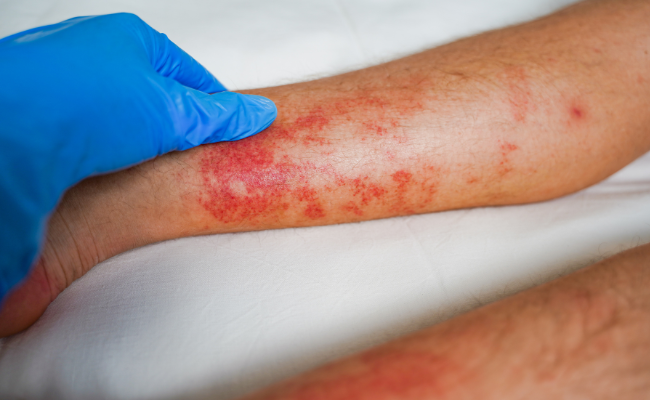How to Treat Microscopic Polyangiitis?
- December 18, 2023
- No Comments

What is Microscopic Polyangiitis?
Microscopic Polyangiitis (MPA) is a rare autoimmune vasculitis characterized by inflammation in small blood vessels, potentially causing damage to essential organ systems such as the kidneys, lungs, nerves, skin, and joints. This condition, falling within the spectrum of anti-neutrophil cytoplasmic antibody (ANCA)-associated vasculitides, arises when the immune system erroneously targets the body's small blood vessels, leading to inflammation.
MPA shares common features with granulomatosis with polyangiitis (GPA), formerly Wegener's granulomatosis, and despite distinct names, both conditions exhibit similarities in their treatments. This underscores a parallel approach in managing these related autoimmune vasculitides, emphasizing the need for specialized care and understanding of their complex nature.
Why Does Microscopic Polyangiitis Occur?
The precise cause of MPA remains elusive, as is the case with many autoimmune diseases. It is believed to be a result of a complex interplay between genetic and environmental factors. In individuals with MPA, the immune system produces ANCA antibodies that specifically target and damage the small blood vessels. This immune response triggers inflammation, which can lead to the formation of granulomas and compromise the normal function of affected organs.
How Does Microscopic Polyangiitis Present Itself?
Microscopic Polyangiitis presents a clinical challenge due to its variable manifestations, making diagnosis intricate. Common symptoms encompass fatigue, weight loss, muscle and joint pain, skin rash, and fever. However, the specific symptoms often depend on the organs affected. Kidney involvement may lead to manifestations like blood in the urine, while lung involvement can result in cough, shortness of breath, and chest pain. Timely detection and accurate diagnosis are paramount for initiating effective treatment and preventing further complications.
Treatment Solutions for Microscopic Polyangiitis
Managing Microscopic Polyangiitis necessitates a comprehensive and tailored treatment approach. The overarching goals are to achieve remission, control inflammation, and prevent organ damage. Here are key components of the treatment plan:
- Immunosuppressive Medications: Central to MPA treatment is the use of immunosuppressive medications to quell the immune response and reduce inflammation. Corticosteroids, such as prednisone, are often the initial line of therapy, aiming for a rapid control of inflammation. In more severe cases or when corticosteroids alone are insufficient, additional immunosuppressive drugs like cyclophosphamide or rituximab may be introduced to achieve more effective disease control.
- Plasma Exchange: In situations where the kidneys are severely affected, plasma exchange may be recommended. This procedure involves removing the patient's blood, separating the plasma containing harmful antibodies, and replacing it with a substitute solution. By doing so, circulating ANCA antibodies and other inflammatory factors are eliminated, contributing to disease management.
- Maintenance Therapy: Once remission is achieved, maintenance therapy becomes crucial to prevent disease relapses. Lower-dose immunosuppressive drugs like azathioprine or methotrexate are often employed for this purpose, offering long-term disease control with fewer side effects compared to high-dose corticosteroids.
- Blood Pressure and Symptom Management: Given MPA's potential impact on the kidneys and the resulting high blood pressure, managing blood pressure becomes integral. Additionally, addressing symptoms through pain management strategies and other supportive measures contributes to the overall well-being of individuals with MPA.
Benefit Points of Treating Microscopic Polyangiitis
- Disease Control and Remission: The primary objective of treating Microscopic Polyangiitis is to achieve remission, indicating minimal or absent disease activity. This not only controls inflammation but also prevents further damage to organs, enhancing overall prognosis.
- Organ Protection: Timely and appropriate treatment safeguards vital organs, particularly the kidneys and lungs, from the detrimental effects of inflammation. Protecting organs contributes significantly to the overall prognosis and quality of life for individuals with MPA.
- Symptomatic Relief: Treatment not only focuses on disease control but also provides relief from symptoms such as pain, fatigue, and respiratory distress. This contributes to an improved quality of life for individuals navigating the challenges of MPA.
- Reduced Relapse Risk: Maintenance therapy plays a pivotal role in reducing the risk of disease relapse. By utilizing lower-dose immunosuppressive medications, patients can maintain disease control with a lower risk of side effects associated with high-dose corticosteroids.
- Individualized Approach: Acknowledging the variability in MPA presentations, treatment plans are tailored to the individual's specific needs. This personalized approach ensures optimal disease management with minimal side effects, considering the diverse nature of this complex condition.
Comments (0)